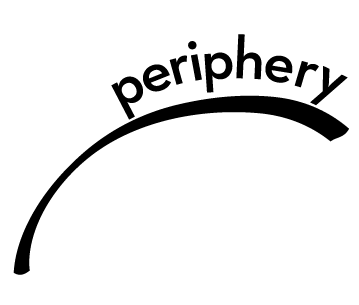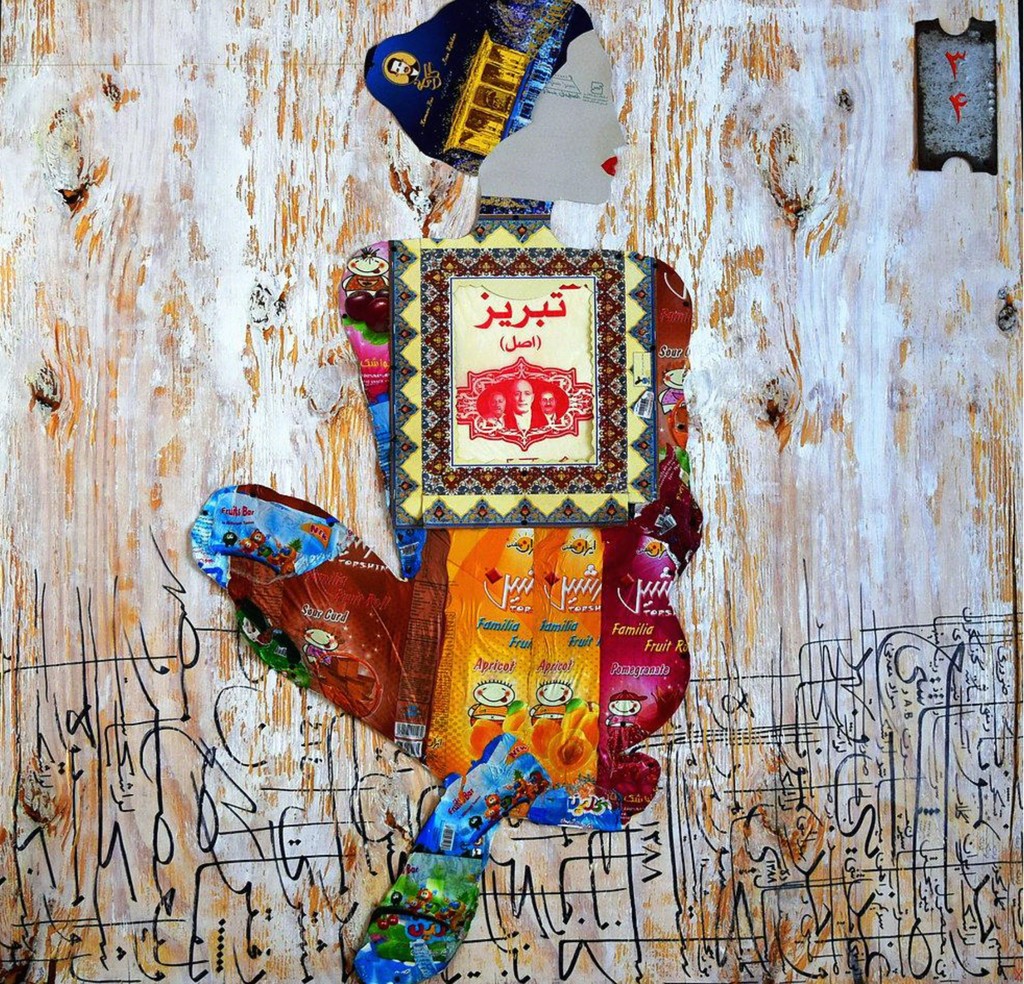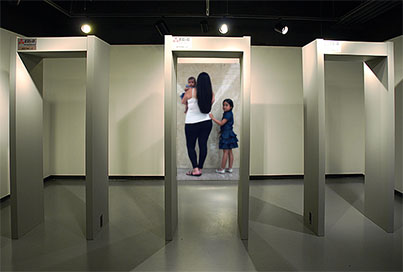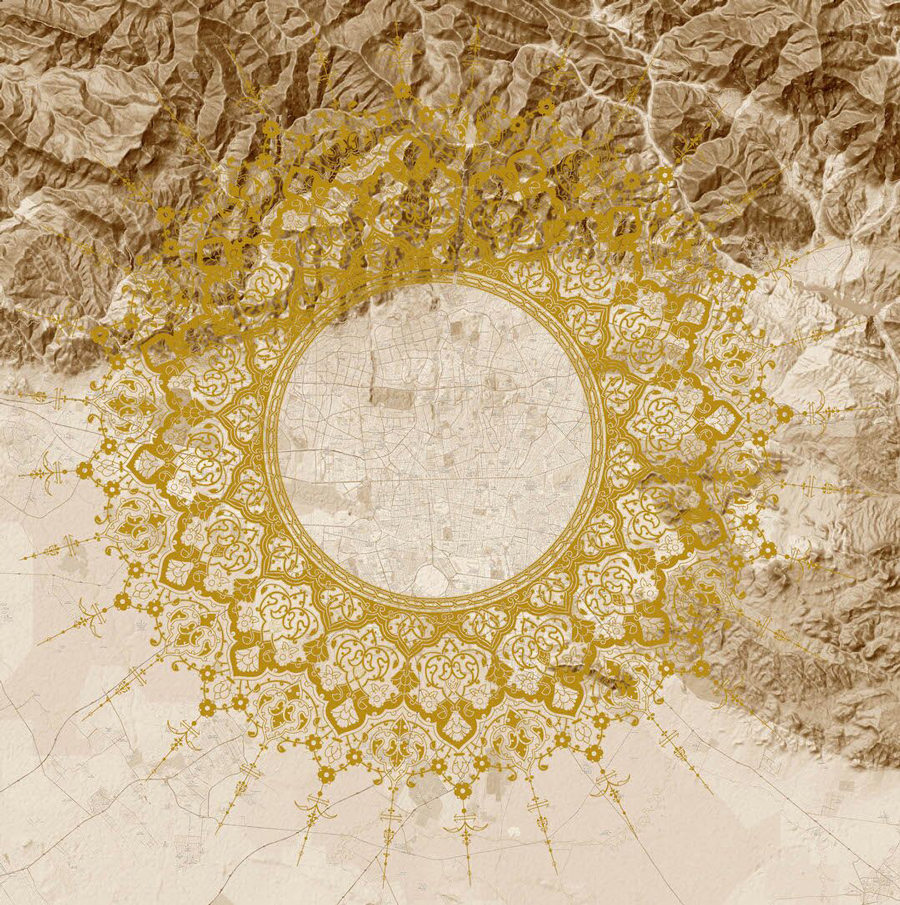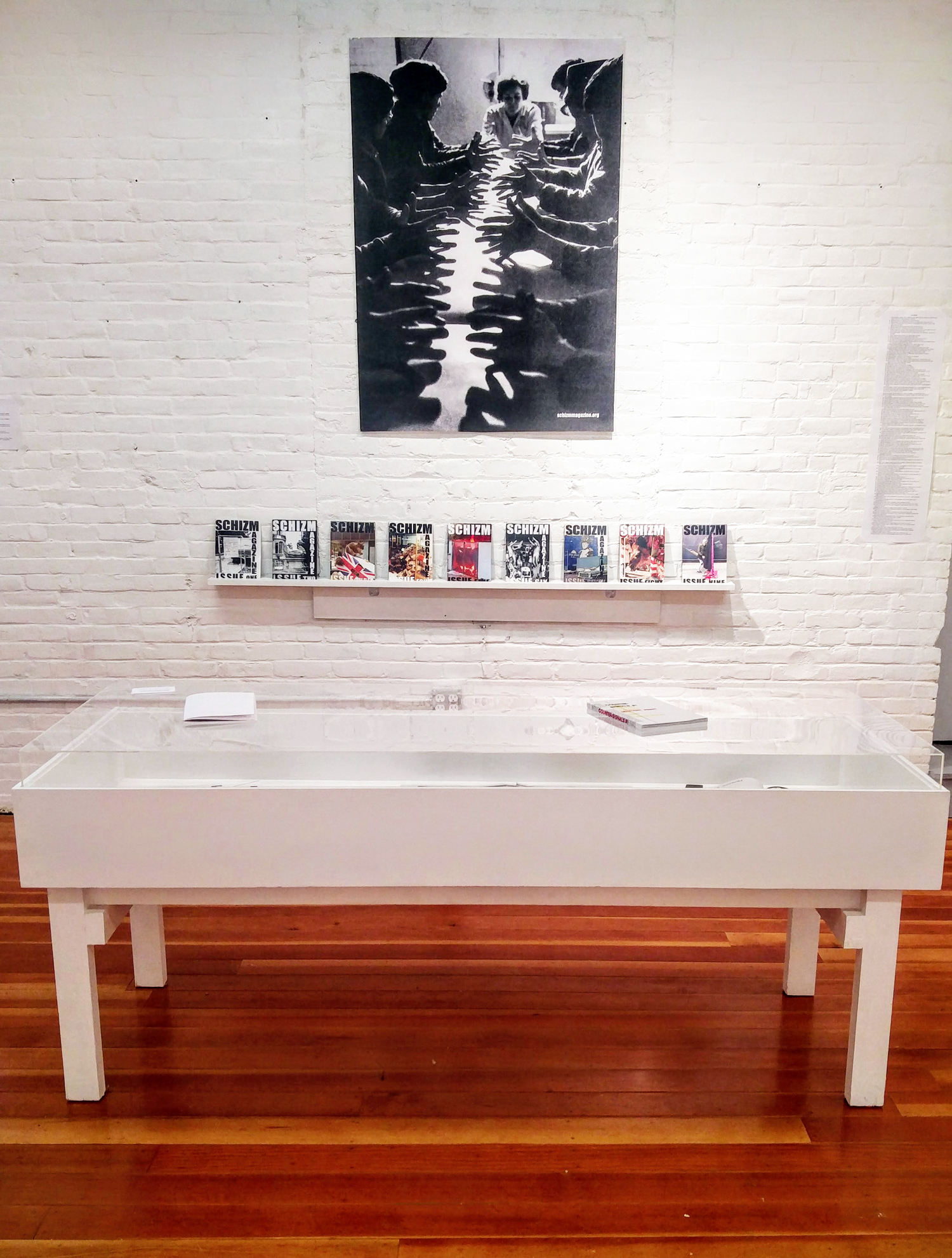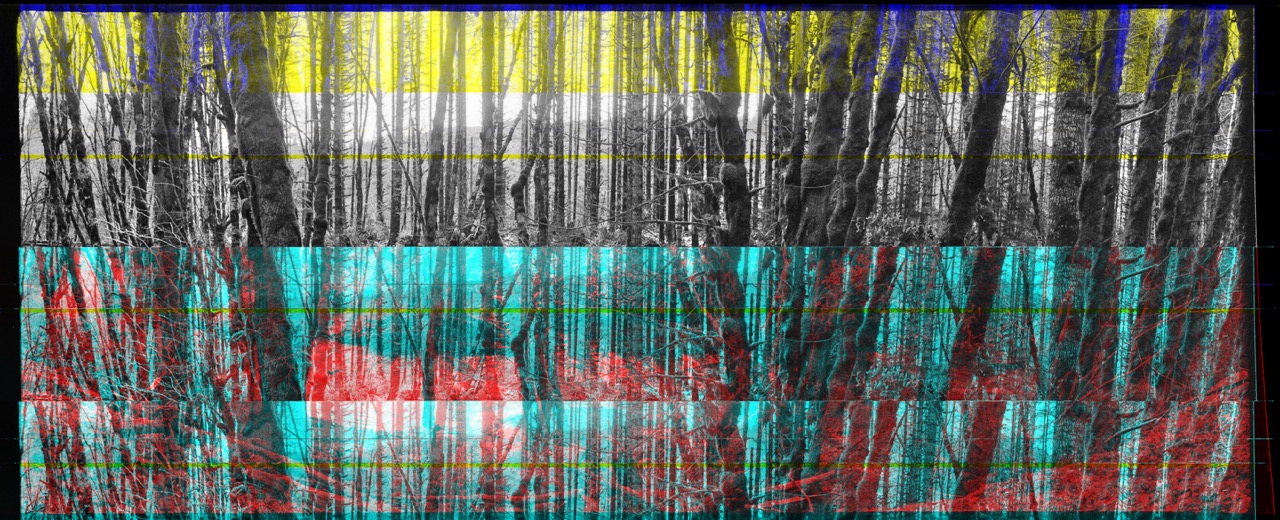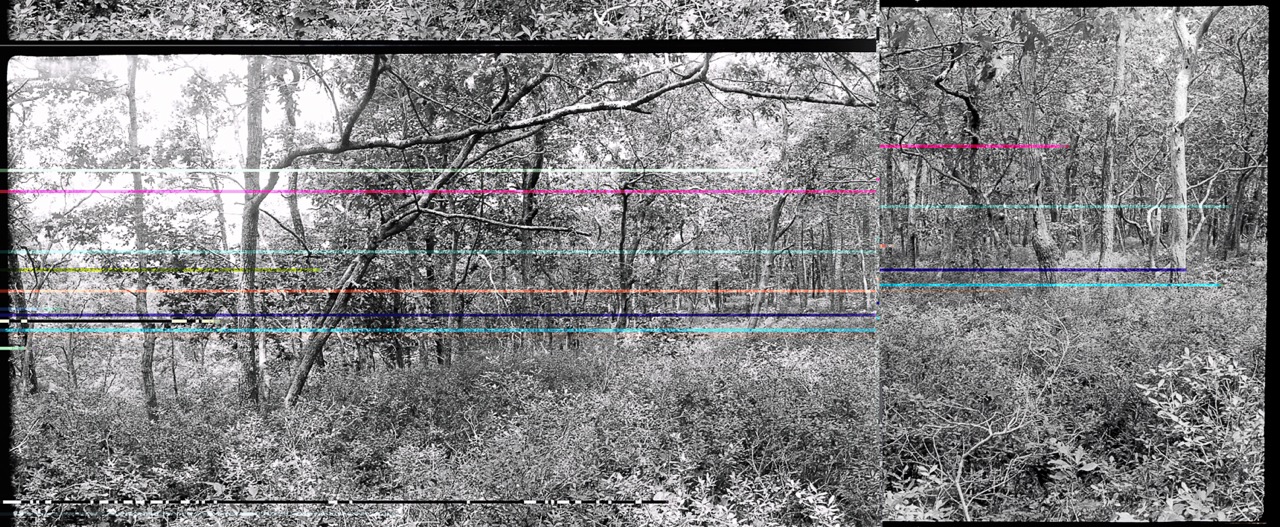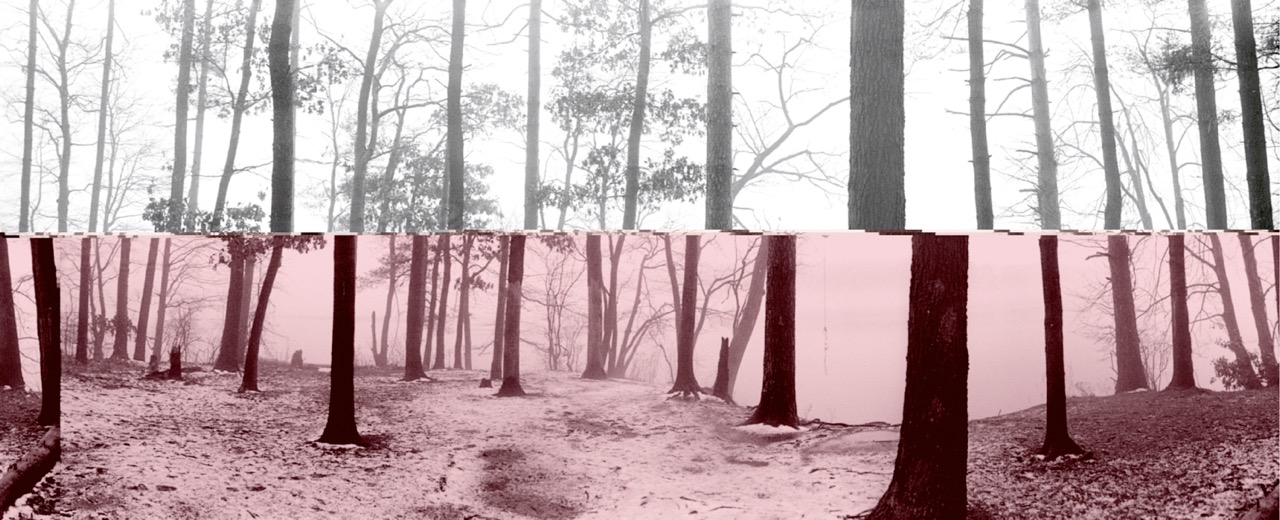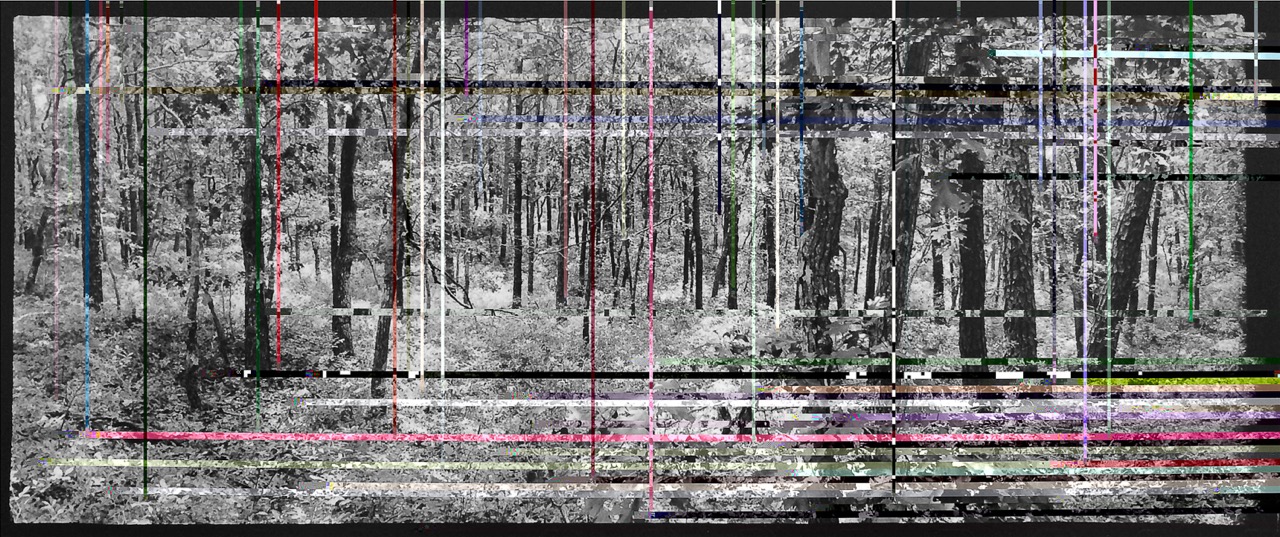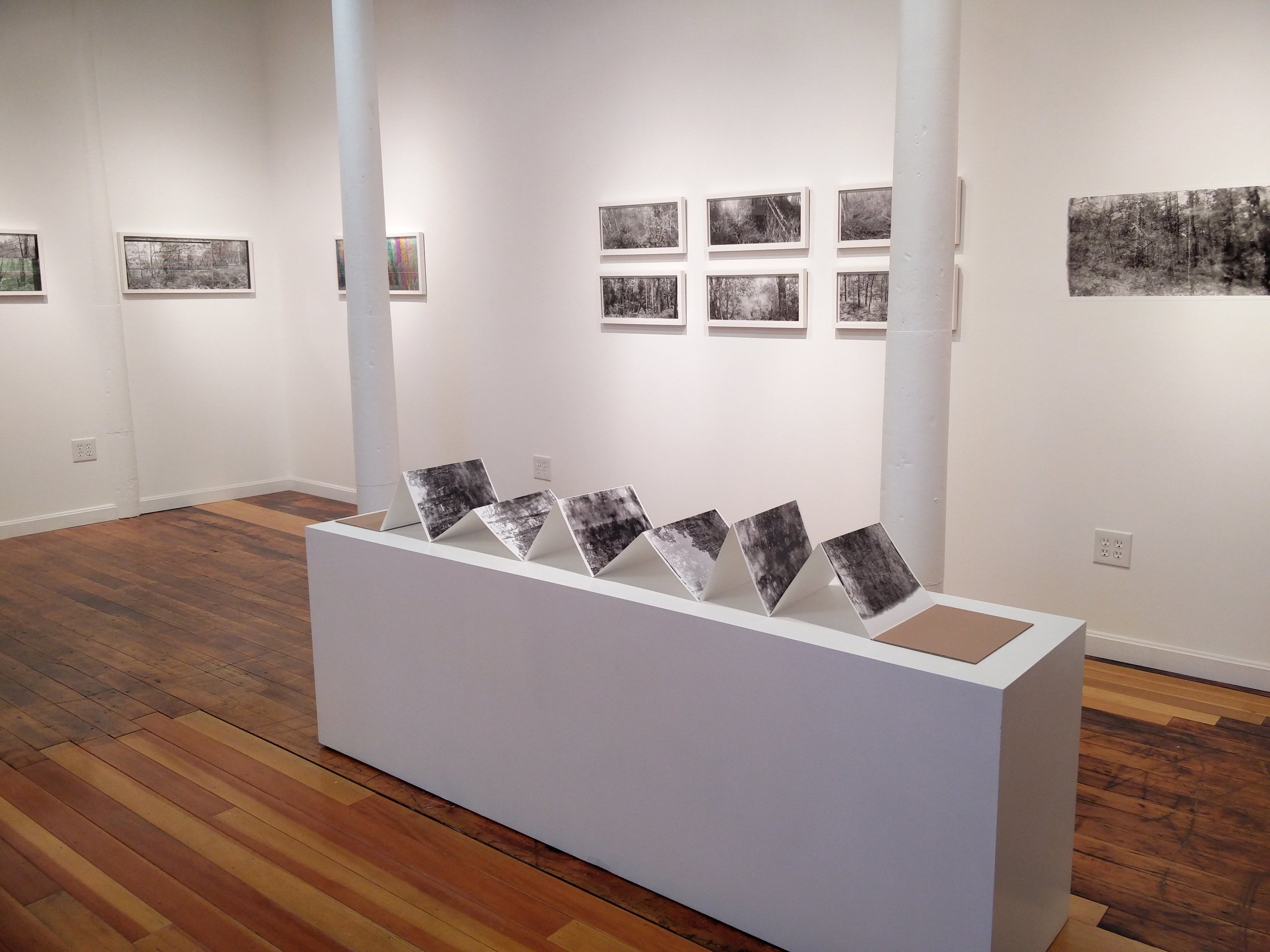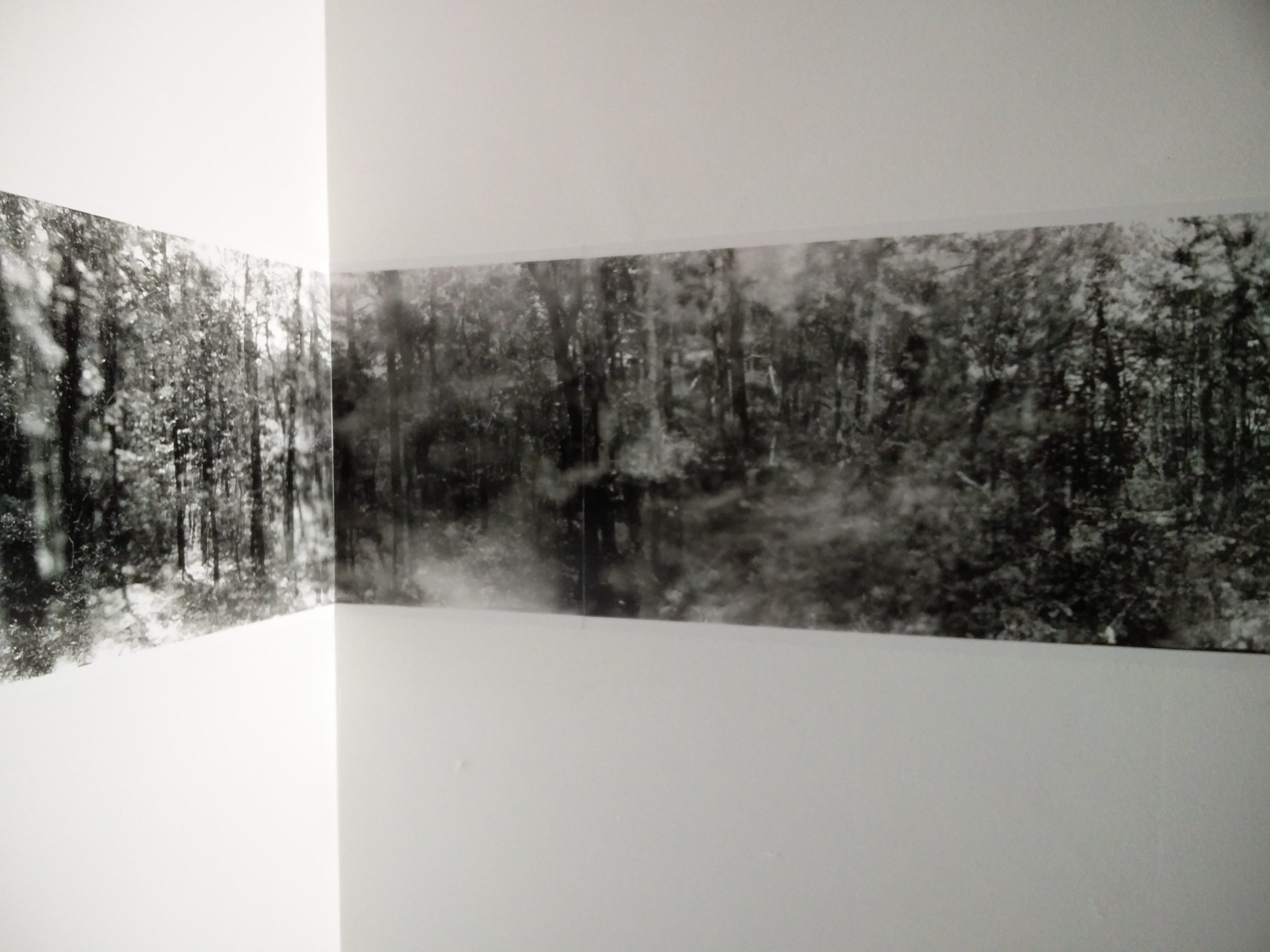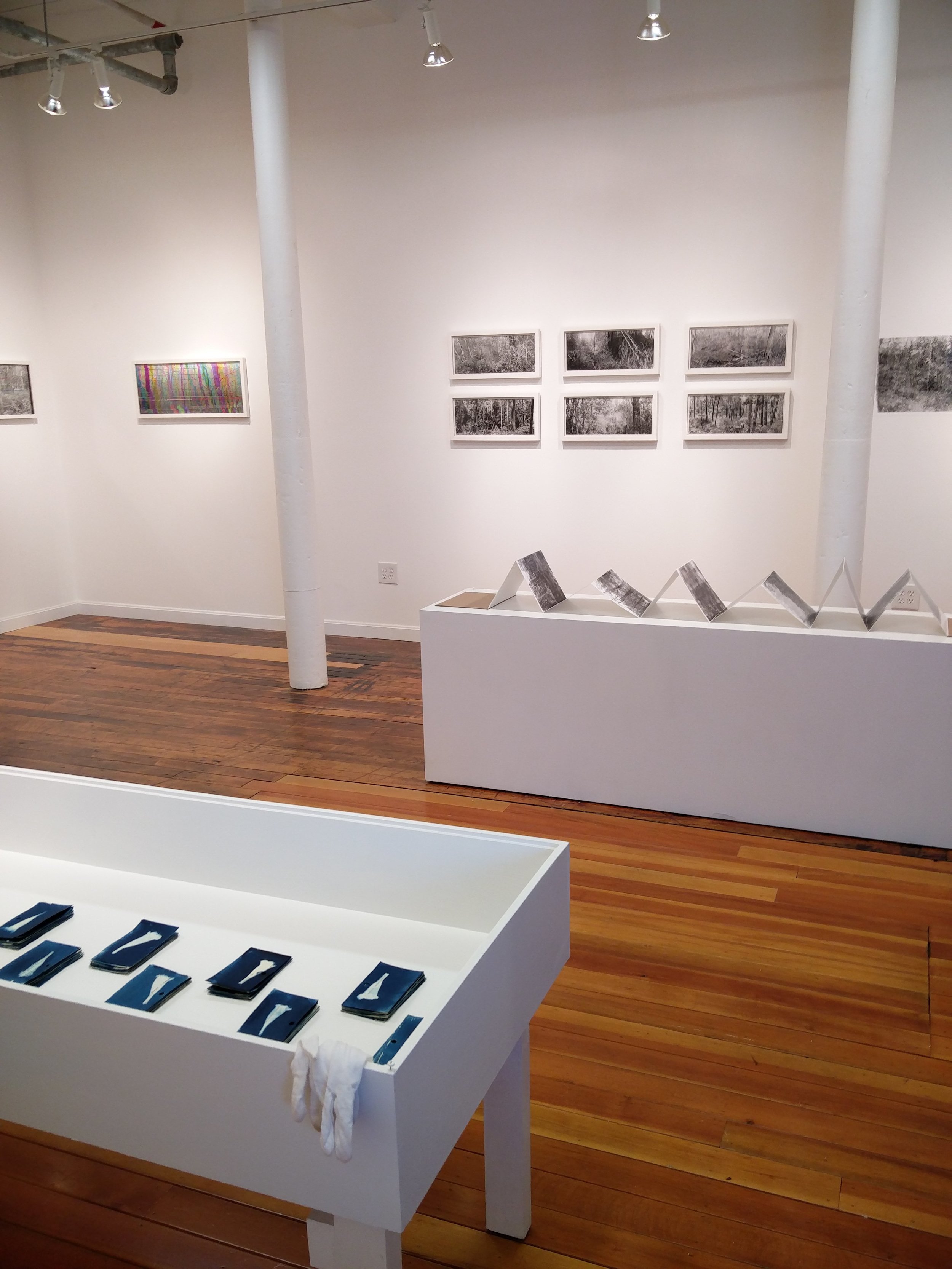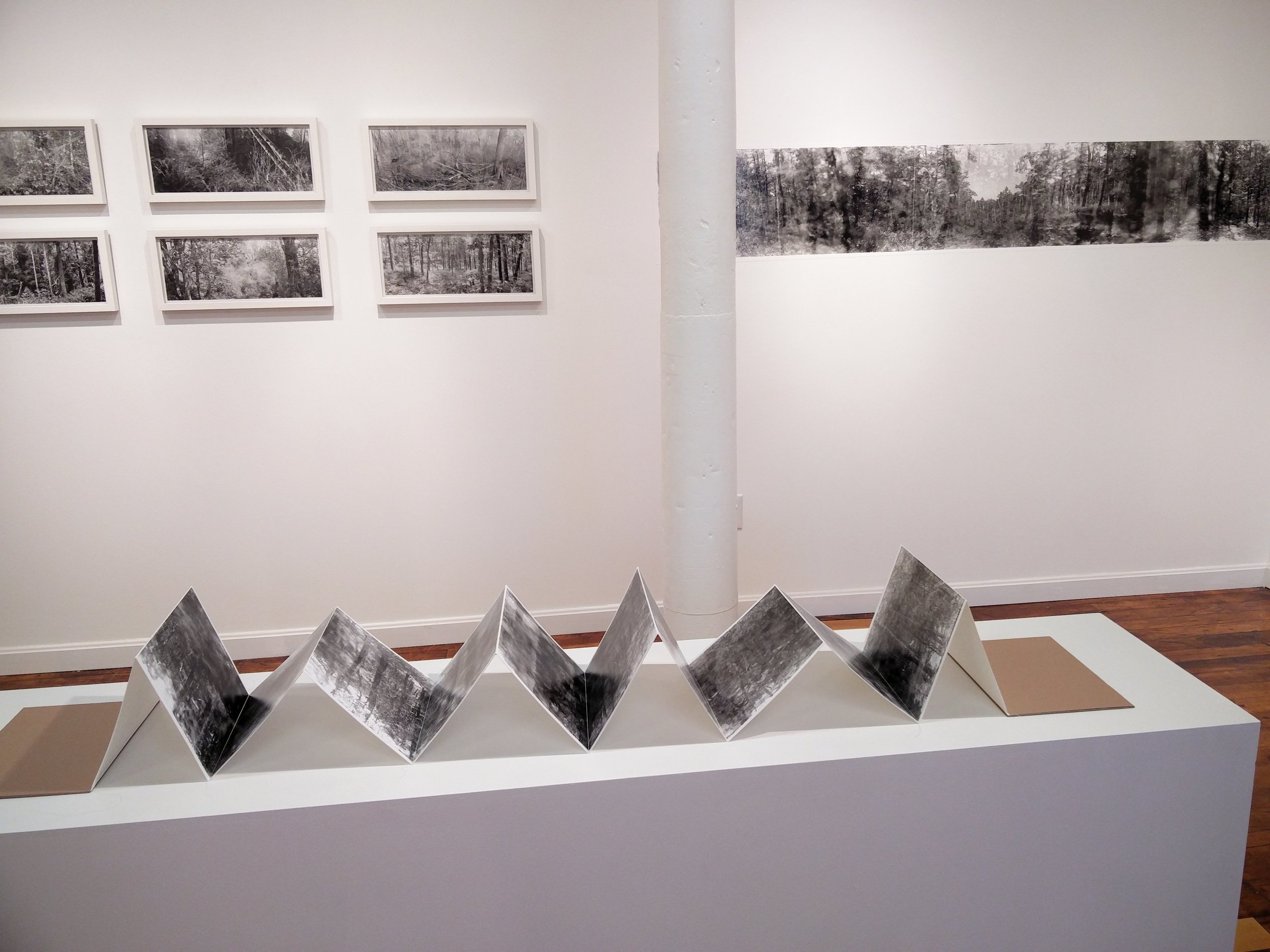past exhibitions in original space
backstory
curated by Barbara Owen + Jon Laustsen
image credit: Matt Chinian, untitled, oil paint, wood. 2012-2017
December 9-23, 2017
Opening: Saturday, December 9, 6-9pm
This past June I stopped in for a cup of coffee to visit my friend, the artist Matt Chinian who lives in Upstate New York. I asked to see his studio, and we walked over to his barn, cups in hand. After decades of making large concrete sculptures of heads and feet he has turned to plein air painting, capturing the small town and the surrounding area where he lives several times a week.
Sitting in his studio surrounded by this weekly practice (hundreds of paintings) I was drawn toward a colorful shape in the corner, a mound of discarded paint, the result of years of scraping and clearing the oil paint from a pallet. I found the shape so strongly sculptural that I was surprised that Matt didn’t see it as art. I found the origin of this accumulated material over time as interesting as the form itself; this by-product of the process fascinated me on many levels. I knew I wanted to curate a show around this piece.
While on a studio visit with artist Jon Laustsen I suggested the idea of developing a show around this concept, as co-curators/co-thinkers. This idea for a show presented many challenges: We asked ourselves what it would be like to ask an artist for “unintentional” pieces. Would artists be open to showing work they might think of as an accident, a remnant, something they had abandoned or even something they did not see as their “art”? What kind of conversation would this generate?
In this spirit we asked nine artists if we could visit with them at their studio as a kind of foraging expedition, to work with them and this idea. To our surprise the artists we chose were game.
This show is a result of these many conversations.
Whether they are made up of left over bits and ideas from other projects, trial runs that never made it into a final piece, or new material that is not yet fully developed by the artist; all the pieces in the show have an interesting backstory.
Artists Taleen Batalian, Matt Chinian, Richard Fishman, Jon Laustsen, Richmond Lewis, Ed Osborn, Academy Records, Dan Talbot and Judyth vanAmringe use video, projections, sound, installation, sculpture, and painting to illustrate their thinking.
Up-Root
curated by Donna Troy Cleary + Tiffany Smith
image credit: Tori Purcell, reliquias, archival pigment print, 2013
October 21 - November 18, 2017
Periphery Space is pleased to introduce New York based curators Donna Troy Cleary and Tiffany Smith.
This is the second exhibition in a series in which guest curators are examining social, conceptually based work that focuses on cultural ambiguity, multiculturalism and what that identity might look like today.
In Up-Root, nine artists explore, in various media, how they bridge gaps between their familial cultural heritages - celebrating, embracing and living within these identities in simultaneity with their American selves.
America has been called the most culturally diverse country in the world. However, a map published by Harvard Institute for Economic Research, shows America somewhere in the middle, behind many Central African, Asian and South American nations. Becoming American is often accompanied by a process of assimilation, particularly for second-generation immigrants, when a need to feel connected in a new community causes some to abandon ancestral traditions. At a time of cultural unrest and spiritual disconnection in America, this exhibition presents artists who embody, perpetuate and reclaim the cultures, ceremonies and rituals of their ancestors as a strategy for wholeness.
This exhibition examines the work of first and second-generation American artists and their families. In his book, The Healing Wisdom of Africa, Malidoma Patrice Some states, “I am tempted to think that when the focus of everyday living displaces ritual in a given society, social decay begins to work from the inside out. The fading and disappearance of ritual in modern culture is... expressed in several ways: the weakening of links with the spirit world, and general alienation of people from themselves and others.” Malidoma Patrice Some believes the Western world’s infatuation with indigenous cultures stems from a longing for the spiritual connections their own ancestors once experienced.
Franz De Waal in, The Age of Empathy, discusses what it takes for an individual to uproot and move to another country. There is first a need, coupled with a sense of independence and a willingness to separate from family and all that is familiar. Those personality traits are passed down generationally, creating a culture of individualism, independence and self-reliance. This is the stuff of American legend and it has been perpetuated by a post-industrial ethos that rewards that mind-set.
Dr. Pauline Boss, in developing her theory of Ambiguous Loss, examined those who up-rooted from their country of origin. She states that this process causes a deep sense of loss with no possibility of closure. She believes that a productive coping mechanism involves embracing the idea of paradox and simultaneity. “You have one foot in the old and one foot in the new. And one can live that way. That may be the most honest way to do it.”
Artists Dana Davenport, Simone Couto, Star Montana, Marilyn Narota, Stephanie Lindquist, Heesun Shin, Tori Purcell, Kathie Halfin and Tiffany Smith use video, sound, installation, sculpture, photography and performance to inhabit this space of simultaneity.
Crossing Borders
curated by Judith Tolnick Champa + Jocelyn Foye
left to right: Jason Noushin, "Lavashak" , 2016 - Camilo Cruz, "Metal Detector", "Adeliz", 2017 - Saman Sajasi, "Glory", 2013
September 9 – October 14, 2017
Resonating with the ongoing immigrant crisis internationally, this focused group exhibition features works by 10 contemporary artists producing remarkably expressive work in various forms and formats—taken together, the work concerns personal feelings of loss/gain, separation and hybridity. Whether currently based in New England, New York, California, India or The Netherlands, the talented and multi-generational artists selected for Crossing Borders draw upon specific and diverse cultural origins that they integrate productively in their work. They manifest this integration prominently and distinctively.
Appropriately, this globally involved exhibition will take place within the cultural melting pot of Rhode Island, a historic and ongoing site of immigration. Suitably nomadic in nature, the first iteration of the exhibition in Pawtucket will be followed by additional variations in Rhode Island venues to be announced.
Arguably it is male, rather than female artists who are the most visible practitioners to emerge internationally during the recent immigration and asylum seeking period. Rather than enforce a new space of marginalization, this exhibition underscores the crossing of borders by women artists, while it teases out and exposes the obligations and burdens that artists of all genders may express in leaving their original countries and communities. To paraphrase critic Kaelen Wilson-Goldie writing recently on art made within Assad’s Syria - and art for its migrants and refugees beyond - the exhibition also will engage “complexities of identity and experience that complicate the binaries of insider and outsider that are often exploited to make people fearful of others.” (Bookforum, April/May 2017, 42-43).
Crossing Borders is not overtly about displacement. Instead, it emphasizes the need for diverse practitioners to develop a secure, confident, personal art language through which to express conditions of movement and change, externally imposed and/or internally generated. As issues of gender, history and cultural practice are addressed through the exhibition, traditional and experimental media both are parlayed deftly in the process, from painting and embroidery through readymades and fascinating mixed-media variations. In addition to animated conversations between diverse contemporary media, shifts of scale are dynamic, ranging from an 11-foot composition to a small-scale animation.
______________________________
The artists featured in the exhibition are mainly active in the USA while born abroad, (generally having moved across several countries), or are second-generation, or were born in the USA and later resettled abroad, or have moved from a smaller-scale to populous urban city that is now called home. They are Roya Amigh, Iran/Massachusetts; Camilo Cruz, Los Angeles, California of Mexican parentage; Teruko Isabella Kushi, Massachusetts of Japanese/American parentage; Ariana Gharib Lee, Massachusetts of Iranian/Chinese parentage; Julia Mandle, Minnesota/Netherlands; Esperanza Mayobre, Venezuela/New York; Jason Noushin, United Kingdom/Connecticut; Saman Sajasi, Iran/Rhode Island; Poonam Jain, Bangalore/Mumbai, India, and Heeseop Yoon, Korea/New York.
Crossing Borders was conceived in and for the contemporary moment nationally and internationally by independent curator, art writer and founder of the Providence Biennial for Contemporary Art, Judith Tolnick Champa, and multi-media artist and active feminist Jocelyn Foye, recently migrated from California to New England.
______________________________
Exhibition brochure
An illustrated brochure with Guest Essay, Curatorial Remarks, Artist Biographies and Checklist, accompanies the exhibition. The guest essay by emerging artist Ariana Gharib Lee, (Brown BA ‘15 in History; Post-Baccalaureate School of the Museum of Fine Arts, ‘17) is rooted in her personal experience as a Visitor Assistant for the Nari Ward exhibition at the ICA, Boston (concluding September 4). Lee’s essay uses this experience as an entry point into reflections on the challenges and pleasures of viewing identity-based works of art such as those featured in Crossing Borders.
The exhibition is supported in part by the [ ] PROVIDENCE BIENNIAL FOR CONTEMPORARY ART
an independent 501(c) (3) founded in 2011. It has been identified with several dynamic exhibitions since summer, 2015, partnering with a range of cultural, artistic and community organizations throughout and beyond the city-state.
July 14 - August 5, 2017
In this solo exhibition Salinas Silva will exhibit a body of work that, in her words are "profoundly influenced" by the writings of Carl Jung, the Swiss psychoanalyst. She writes; “His view that humankind cannot be healthy until as individuals we embrace our shadow, or the darker, more unruly parts of ourselves, has become crucial to my work.”
What is striking in Kim Salinas Silva’s work is her painterly expression and ease in describing representational forms. Her use of color and composition is topical and current, and she lays it on richly for the viewer. The cast of characters in each painting are revealed in the simplest of brush strokes and yet they are complete; there is no mystery. But most importantly she wants us to see what those forms and characters are acting out. The scenarios are quite hard to look at even in their candy cartoon colors. There is a concern that asks to be explored, considered and recognized. At the heart of this she wishes to covertly address the suffering and abuse of animals and children.
Kim Salinas Silva could be thought of as the reincarnation of the writer Flannery O’Connor as painter. Born and raised in Louisiana, Kim is a southerner like Flannery and shares a southern gothic style and sensibility. Like Flannery, Kim's grotesque characters and illustrations ask questions about morality and ethics.
“The images in my paintings arise directly from my subconscious, similar to dreams. One night’s dream is different from another night’s, yet a crew of familiar symbols and archetypes runs through them, over the years weaving together an intricate tapestry of psychic story-telling. Each painting tells a different story based upon the urges intrinsic to that particular painting time, yet common motifs unite them all. The story will be completely fantastic, yet couched in human emotions.”
Artist Statement
My paintings are like a puzzle. They are improvisatory; I never know what the image will look like by the end of our escapade. To start, I sketch directly onto the canvas with a few pencil lines and imagine a direction from observing those shapes. This soon may lead to a fully realized painting. However, in the quest for something I’ve truly never seen before, I may turn it around and discover a new story line with new characters. I’ll continue working from there and end up with a completely new twist. I feel satisfied when a painting is so goofy, and so oddly charactered that I could have never dreamed it up from straight out of my head. The story will be completely fantastic, yet couched in human emotions. It is an absorbing adventure, with the process being as engaging as the result.
I add a heavy dose of dark humor to maudlin happenings like humiliation, rage, meltdowns, alcoholic dysfunction, etc. I enjoy the outlet of creating an emotional mess without being politically correct about it.
Artist Bio
Kim was born in Shreveport, Louisiana, and grew up in a small town not far away called Minden. Behind her childhood home, she roamed the pastures and fields, which were filled with cows and horses. Crawfish and minnows populated the creeks, and she loved to observe them. Nature remains calming and restorative for her. The plight of animals is an ongoing concern and indirectly or not, is her subject matter.
After winning a full scholarship, Kim moved to Houston, TX to attend The Art Institute of Houston. She lived and worked in Houston for the next 30 years, doing both commercial and fine art. She received a Bachelor’s in Arts degree from Vermont College, and an MFA from Savannah College of Art and Design. She has one grown son, Damian. She and her husband live in Pawtucket, RI with their 9 year old French Bulldog rescue, Moxie.
EMMA HOLMES | Schizm
June 16 - July 8, 2017
Artist statement
For the past ten years my work has been engaged primarily with printed and published material through two concurrent practices, studio based works on paper and a self-published magazine called Schizm.
Schizm Magazine came about following a collage exhibition called Schizmo, which I organised and curated in London in 2009. The first issue of the zine was made just after that show as a way to gather together images & ideas and share them in a cost effective and direct way. For the second issue I began inviting artists to contribute a page in response to the theme: ‘Time doesn’t give a shit’. Schizm, as the title implies, aims to tackle ideas concerning discordancy, contradiction and paradox and the themes are a way of instigating a response and focusing ideas. Since then there have been many themes, some related to time, others focusing on current cultural and sociological concerns.
Digital self-publishing was becoming easy and inexpensive by then, although in London it wasn’t as widespread as here in the United States where there is a long & rich tradition of artists self-publishing. With desktop publishing tools and YouTube tutorial videos, anyone with a MacBook and InDesign could make a low budget magazine where an artist can take on the role of curator, editor & designer, as fluid d.i.y. modes of production. In this way Schizm was built up little by little, developing a process that can allow for an element of improvisation in publishing. This is possible through the use of a consistent and simple design format, & a classic low cost zine aesthetic. The uses of some constant elements have also helped to anchor a particular look & feel. For example, the front cover is always a photograph taken in the street, and the back cover is an unusual image of women (as a small gesture towards redressing the balance of annoying images of females which generally prevailed growing up), as well as the inclusion of work by regular contributors: Sam Basu and John Chilver’s texts, and Bob Ajar’s photographs.
Schizm is concerned with finding and making original content that relates to the thematic proposal through the use of associative thinking. Then, the focus is on the editing process, by sequencing and balancing the material, and incorporating the pages sent in by invited artists and writers from all over the world. Usually there are fifteen or so contributors who are invited to send in material to be published. The material is not chosen before hand and therefore whom I invite to contribute to the magazine has to be carefully considered. I veer away from straightforward images of an artist’s work, as it is not an art magazine in that sense at all. I am ultimately attempting to present an art object that compiles the work of many artists and employs humour and social commentary as a way to examine ideas concerning hierarchy and paradox.
Now in its ninth issue and incorporating the work of over a hundred contributors, Schizm Magazine is an experiment in collectivity. Schizm attempts to pose questions regarding the contradictory role of the art object and it’s context, while presenting an alternative view of how to consider this, in new and potentially interesting ways.
Artist Bio
Emma Holmes was born & raised in Madrid, and lived in the United States and Chile, eventually settling in London, England. She received a BA from Bennington College, USA, and an MA in Fine Art from Chelsea College of Art and Design, London, in 2000.
Holmes has exhibited widely, as well as organised events and presented Schizm Magazine at art book fairs in Europe and Mexico. Recent exhibitions include: Technics and Time, Arno Eichhorn HQ, Berlin (2016), Pigdogandmonkeyfestos at Phoenix Gallery, Exeter, UK (2015), Dotland at A Space, Berlin (2014), The Group at Rollaversion, London (2014), The Fiction Show at Rivington St. London (2013) and The London Open at Whitechapel Gallery, London (2012). Recent contributions to publications include: Counter Signals 1, Militant Print / A Form Oriented to it's Own Circulation, edited and designed by Jack Henri Fisher and published by Other Forms, Fall 2016 - Winter 2017.
PETER RICHARDS | The flowers not here yet/the flowers gone
June 2-10, 2017
Periphery Space is pleased to present the recent mono-prints of the Vermont based poet Peter Richards. As the title and image suggest Richards is a storyteller both visually and verbally.
What kind of imagery does a seasoned poet who turns to painting create? For the past two years I have watched as Peter has developed a language and energy in his paintings that for many of us who know his poetry recognize. In both there is a vigor that sparks and crackles. I have been in his studio and watched him wrestle with a painting as he bodily works the surface scraping, layering, wiping all with speed as he seeks to capture something that he sees.
Reading a review of Richards' work by the poet and editor Robert Fernandez, I find that it could be just as fitting a description of his paintings. He states that the poems of Peter Richards’s show the poetic function at a revelatory pitch, sound spilling over into sense and seeing and recursively drawn back again into earthy flintiness and drive.
This feels like the case of when painting and poetry can perform functions of the other and inspire for the reader/viewer what the other cannot. Peter is lucky to be able to describe in both forms.
-Babs Owen
Artist Statement
In this new work I want each piece to tell a story, but with only the aura of a story and perhaps it's setting doing the telling. I enjoy reading stories and so I’m interested in the ways stories evoke, transport, and enlist the reader into adventures built more out of atmosphere, tone, and voice, than what is ostensibly narrative. While events in life are important, I find it curious, and perhaps it stands as a rule—a great novel is great always despite it’s story. So I look in this new work to explore the question— outside of figure, what are some of the utilities a painting enjoys for creating realities that are at once habitable, intimate, and convincing. I’m also curious about the activity that exists somewhere in the overlap between viewing a painting and reading a text. I like to populate my paintings (suggestively) with what might be perceived as purely imaginary letters, and from alphabets and languages that are equally imagined. Imagined, but are they real? and if so, what are the semiotic, aesthetic, and spatial consequences when such lettering presents itself as not only imaginary, but also biological in form, and sentient in disposition? For me the question occurs simultaneous with the painting becoming embryonic in its outcome, and perhaps even still astral yet in the stage and mode it presents itself to the viewer. And as much as I want my painting to each one tell the particular story of how it came into being, it’s also true I wish for the viewer’s attention to absorb into the painting as one of its happily imagined, and living constituents. -PR
Artist Bio
Peter Richards is the recipient of a Massachusetts Cultural Council Grant in Poetry, an Iowa Arts Fellowship, an Academy of American Poets Prize, and the John Logan Award. His poems have appeared in Agni, Colorado Review, Denver Quarterly, Fence, The Yale Review, and other journals. He is the author of OUBLIETTE (Verse Press/Wave Books, 2001), which won the Massachusetts Center for the Book Honors Award; NUDE SIREN (Verse Press/Wave Books, 2003); and HELSINKI (Action Books, 2011). He has taught poetry at the University of Montana (Richard Hugo Visiting Poet), Harvard University (Briggs-Copeland Lecturer), Tufts University, Museum School of Fine Arts, Brown University, Champlain College. He lives in Vermont, where he writes and paints.
Grids
Curated by Barbara Owen
April 29 - May 27, 2017
Periphery Space is pleased to present Grids, a show that includes painting, sculptural painting, drawing and dance. The title and subject of the exhibition is taken from the influential 1979 essay Grids by Rosalind Krauss.
This group show focuses on six artists who have a shared fascination with the grid using various media. In object, movement or surface each artist explores a meditation on pattern, repetition and geometry in nature and everyday life.
Exhibiting artists: Tara Fracalossi, Kinderhook, NY, Lila Hurwitz, Newport, RI (performing with dancers: Shura Baryshnikov, Heidi Henderson, and Cathy Nicoli), Jacqueline Ott, Providence, RI, Lisa Perez, Providence, RI, Neal Walsh, Foster, RI and Laura Watt, Garrison, NY
“In the cultist space of modern art, the grid serves not only as emblem but also as myth… The grid’s mythic power is that it makes us able to think we are dealing with materialism (or sometimes science or logic) while at the same time it provides us with a release into belief (or illusion or fiction)”1
Mondrian, Agnes Martin, Peter Halley, Terry Winters are several artist’s heroes who dove deep into the grid and in doing so revealed new ways of using, seeing and thinking about the grid. The artists in this show are continuing this practice.
Historically in Lisa Perez’ work, she presents the grid as an object. Keeping the physical nature of her material in mind (rough cut canvas, bumpy paper maché, smooth paper) she also uses as a material the “illusion” of a reflected shadow to embody lines that describe her form. It’s real and not real, you can see it but not always touch it.
Like Perez, Neal Walsh often blurs the line between painting and sculpture. He uses cut squares of canvas, often repurposed, which he fixes onto a new surface and paints over in multiple layers. He creates a grid and works to keep it evident, while at the same time softening the lines with thick paint. Equalizing each square into a whole, they simultaneously exist as both material and content.
Lila Hurwitz and fellow dancers (Shura Baryshnikov, Heidi Henderson, and Cathy Nicoli) will perform movement works influenced by dance artist Barbara Dilley’s exploration of the “grid” begun in the 1970s. Dancers start with a limited range of movements in a set configuration. This constraint system tunes both the dancers’ and the audience’s attention and perception, "[A]t first, the grid may feel confining, an orthogonal prison of left and right…after a bit of work, it magically opens up (and) dancers find that they no longer have to follow it." 2
This kind of thinking is reminiscent of the work that Jacqueline Ott has long been creating. The immaculate precision and rhythm of her works is mesmerizing. As she makes her marks within the constraints of a grid, one senses a dance being performed on paper—brush stroke to the left, stroke to the right, counting as she goes, building up in layers her design.
Ott shares this observation of pattern and repetition with Laura Watt. Whereas Ott dances with her brush, Watt fiddles with her grid, warps and distorts it, seeing geometries and spatial structures. In her work one can see the preliminary penciled-in grid upon which she builds. The grid that Watt is building hints at a story, long and complicated, that needs to repeat itself.
Tara Fracalossi’s ongoing series called Archive uses picture-taking as a diary of her personal life and presents them as systems and grids that one reads as color and pattern first, and individual images later. Like the grid dance, Fracalossi is addressing repetition of movement: even though the pictorial box of the photograph will remain constant, what the photographer sees though the viewfinder is always changing. Presented this way, one sees more than just a photograph.
1 Rosalind Krauss. “Grids.” October, Vol. 9 (Summer, 1979): p54
2 Barbara Dilley in conversation with Melinda Buckwater,“Composing while dancing: an Improviser's Companion” Univ. of Wisconsin Press: p77
ROBERT PAASCH | REALITY DUALITY Paintings from the Open Block Grid Series
OBR #42
December 3, 2016-January 14, 2017
The paintings in the Open Block Grid series attempt to visually address the idea of the mind superimposing its convictions onto nature and thus transforming and shaping (our experience of) reality. We don’t see what is, but what we choose to see, with the mind acting as a sort of filter that has been shaped by our past experiences and the resulting beliefs. Hence, there is a duality between reality and what we perceive as such.
Using two different modes of abstract imaging, i.e. a hard edge grid akin to computer pixels and Op Art, and a fluid gestural expressionism, Paasch somewhat playfully explore this duality as well as the circular interconnectivity between its parts. The grid refers to the act of mental compartmentalization, i.e. identifying/naming, locating/mapping etc., which aids us in our attempt to comprehend and navigate our experiences. It is superimposed onto the ground, which can be seen as referring to raw, unfiltered reality, or else as a sort of psychological (land-)scape or backdrop that dwells in the subconscious.
The grid takes it’s initial cue, namely it’s color scheme (at least for the first few colors) from the background, after which it is developed like a game. Each color is meant to appear the same number of times while it is not allowed to be right next to itself. As in Solitaire, this does not always work out, but so be it. Often it does.
In the finished painting, the grid and ground exist simultaneously. Like two aspects or versions of a single occurrence, at once enhancing and partially obscuring each other, they co-exist in a circular, interactive relationship.
Artist Bio
Robert Paasch was born and raised in Berlin, Germany. He first moved to the United States to study jazz composition and arrangement at Berklee College of Music in Boston, Massachusetts. While pursuing his studies, Robert also began spending much of his time painting and exhibiting in local cafes. After moving back to Berlin for a year, he decided to return to the United States to attend Bennington College in Vermont where he continued to study music but switched his main focus to the visual arts. In Vermont he also began to develop an interest in the philosophy of science. The ideas encountered in this discipline, concerning itself with perception and verifiability, fascinated Robert and have informed his art ever since.
Paasch is an independent artist living and working out of Queens, New York. He is also the installation preparator and coordinator at the Rubin Museum of Art in Manhattan.
Robert has exhibited both in Europe and the United States. He holds a B.A. in Painting and Drawing from Bennington College and an M.F.A in Painting and Printmaking from Yale University.
www.robertpaasch.com
TINA TRYFOROS | IMPERFECT PARADISE
Wellfleet Woods, 2015
October 6-29, 2016
Tina Tryforos presents photographs and book works from her series Interference, Lovely, Dark and Deep and Trumpet.
In Imperfect Paradise images of nature become metaphors for the uncontrollable and mysterious forces in our lives: flowers stand in for individuals linked through tragedy, serene landscapes are disrupted with color aberrations, beauty is subverted.
Accidents shape my photographic work. Light reveals its materiality through double exposures and chemical abnormalities. Data unwittingly glitches during ordinary digital exchange. These phenomena happen by chance during my process. Through them I explore humans’ interference in the natural world, a longtime focus of my work.
I set out to document my apprehension with the woods. Dangers and mysteries lurk there, and the wall of growth that confronts me at the edge of the woods is dauntingly impenetrable. I look to the woods as both a boundary and a transition point. Crossing that boundary changes your landscape, perspective, and possibly state of mind. The tree line is the threshold where culture and comfort yield to wildness and awe. To enter the forest is to risk getting lost.
Unfortunately, I fear the adjusted, fragmented, and unnatural beauty that reveals itself in these pictures may foreshadow our future. -TT
Artist Bio
Tina Tryforos is a photographer, bookmaker and educator based in Rhode Island. She explores human ecology and the complicated relationships people have with the natural world. Her experiences with nature were informed by the urban surroundings of a child growing up in Queens, NY in the 1970’s. Nature seemed mediated and compromised by human intervention, including her own. Her photographs are quiet comments on the disquieting evidence of how humans are playing with our planet.
Tina Tryforos has a BA in Art from Union College and an MFA in Visual Studies from the Visual Studies Workshop in Rochester, NY. She teaches photography and digital art at the Community College of Rhode Island.
MARKUS BERGER | RE-MAKING
May 21 - June 18, 2016
Nelson Goodman writes in Ways of World-making that “Worldmaking as we know it always starts from worlds already on hand; the making is a remaking. Nothing exists for a first time, nothing is new”
My work engages obsolete and discarded objects and materials and (re) interprets them to find new meaning and expression. The creative process includes the gleaning of past things made, reading and re-reading its stories, technique, materials and past values. Deconstructing, in order to further reveal the past and construction, classification and analysis of all the individual members and the Re-construction, appropriation and re-interpretation are part of each individual piece of work.
"The act of de-construction, the opposite of the original making and assemblage is the tipping point of my transformative work that engages the viewer from one status to another. While in the material word the object remains essentially the same, the de-functioning, de-constructing and appropriating creates another word of being. -MB
Artist Bio
Markus Berger is an associate professor of Interior Design at RISD, a registered architect (SBA) in the Netherlands and principal of the Providence-based art/design studio InsideOut Design. He is a co-founder and co-editor of the journal Int|AR, which encompasses issues of adaptive reuse, preservation, conservation and spatial alteration. Through his work, research, writing and teaching, Berger critiques conventional architectural practices and explores how art and design modifications and interventions can activate change in the built environment.
